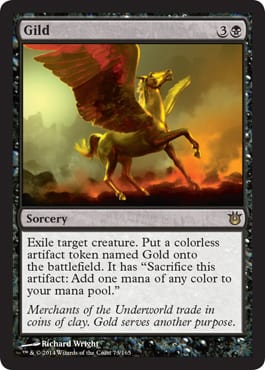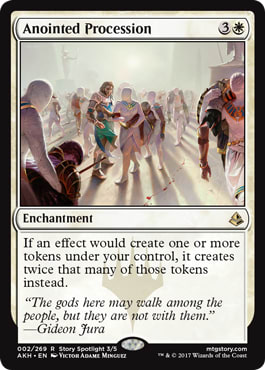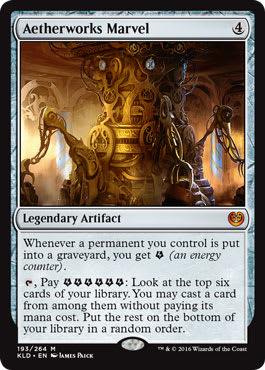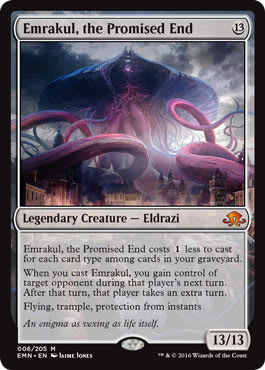By the time this article hits the virtual streets, I’ll be competing in my 21st Pro Tour, Amonkhet in Nashville. While that’s a number I never seriously considered hitting when I first picked up a Magic card in middle school, I’m honored to have made it as far as I have, and I’m considering each and every PT from here on a major milestone and a gift. For so many of you reading this, just attending a single Pro Tour would be an amazing experience, and I think that many professional players forget about that quickly after making their big breakthroughs. Myself, I’ve never had that crazy breakthrough finish, never won a GP, never Top 8’d a Pro Tour, but even so, seven years on and off the train brings some cynicism and perspective that sometimes eclipse the pride I should feel every time I sit down to the first round of a PT.
Why am I taking the time now to wax rhetoric about the need for awe from even the most weary Pro Tour regulars? Well, it just so happens that at the most recent Grand Prix in Richmond, I acquired just enough Pro Points to bring my yearly total to twenty-nine. What’s so great about this number? Well, even if I fail to get a single extra point from a Grand Prix, and even if I go 0-5 at the next two Pro Tours, I will still end the year with exactly thirty-five Pro Points. Thirty-five is the magic number for Gold level in the Pro Players’ Club, which means that after two years in Silver-level purgatory, I will once again be back in the privileged position of not having to fight for my invitations to Pro Tours. Oddly enough, the feeling here is one of relief, tinged with a bit of disappointment for losing consecutive win-and-in matches at the GP, rather than the elation that came with my first year of hitting Gold. Like I said, professional players develop a tolerance for winning, one that dulls the highs of success. My biggest goal for this Pro Tour, outside of winning as many matches as my luck will allow for, is to appreciate the experience. To recapture some of the joy I had at seventeen and eighteen, when I first started this journey. If I can do that, it won’t matter if I’m playing Zombies, Mardu, Marvel, or some rogue pile, and it won’t matter if I draft a disciplined ![]()
![]() Aggro deck or a wild and crazy
Aggro deck or a wild and crazy ![]()
![]() double Anointed Procession deck like I did on camera at Richmond.
double Anointed Procession deck like I did on camera at Richmond.
To better appreciate what the next six or seven Pro Tours hold for me, I’d like to take this article to look back on the last year, since I made the decision to take a year off of real life and pursue professional Magic full-time. Nickel-and-diming together 35 Pro Points is no mean feat, although it requires dedication and repetition more than spiking a Pro Tour. If I can do it, you can probably do it too. Here’s one man’s voyage from “I think this might be the end of the Pro Tour line for me” to “Looks like they’re gonna have to handle 40-Card Friedman for another round of PTs!”
For most professional players, the bulk of their Grand Prix points come from solid 12-3 finishes at these tournaments, which award three points apiece. Two or three of these, combined with a solid 10-6 finish at a Pro Tour, almost guarantee a Silver invitation to continue the quest. Flailing around with a bunch of 11-4 or 10-5 finishes will get you nowhere fast, with 15-18 points and the hope that you can “paint over” your mediocre finishes with better ones. See, because of the six-GP cap, you only count your best six GP finishes toward your Pro Point total for a year. This benefits pro players who would rather be more selective with their GP attendance (in order to devote more time to other life pursuits, perhaps?), to the detriment of those perma-grinders and pros for whom nothing will ever be more fun than planning for and attending the next Magic tournament. I knew from the get-go that if I didn’t start with at least a 12-3 finish and an RPTQ win, the journey for Gold was going to be a *lot* harder. Luckily, my first GP of the season was in Indianapolis, at the end of August 2016. Brandon Burton took the whole thing down with Burn, and I lost in the last round to go 12-3 (which stung a lot, no doubt about that), but it was a start. Bant Eldrazi was the weapon of choice, and back then, most people still didn’t have much of an idea of what the deck did, how it operated, how to win the mirror match, and how to sideboard. I had a huge edge (especially in the mirror matches), and that tournament helped solidify my confidence in my Modern weapon. For several months after that tournament, if I was playing Modern for stakes, I was packing Thought-Knot Seers and Noble Hierarchs.
Next up was Pro Tour Kaladesh, with East-West Bowl renting a big house on the North Shore of Oahu, and a week’s worth of testing resulting in us playing . . . Aetherworks Marvel. Marvel is a powerful but inconsistent deck, and lots of professional teams thought they could gain a surprise edge by packing the all-in Marvel monster. Surprise, surprise, we all ran into each other and ended up making ![]()
![]() Flash the breakout deck of the tournament. I managed to pull together an inauspicious 1-2 start (with a Chandra, Torch of Defiance in my draft deck, too!) and rally back with a 3-0 Temur Energy delight of a draft deck to put myself at 10-6 and nine points on the season. With a backup Silver invitation still in my pocket, this was most of the way toward re-upping Silver and getting to play the rest of the Pro Tours for this season. I won’t lie, at that point I was still mostly in a conservative mindset, hoping to just keep pace and qualify for all the Pro Tours. I spent some time hanging out in Honolulu with Travis Woo, Dan Jordan, Bob Victory, and my younger brother Efrem the week after the Pro Tour, rapping about life and talking about our plans for the year in between bouts of jet-skiing, gelato, and hiking. It was an invigorating week to start the professional Magic year in earnest, and I returned to the East Coast in time for GP Providence with Mardu Vehicles in tow, ready to make a deep run. Unfortunately, my deep run ran dry with losses in the last three rounds to go from 11-1-1 to 11-4-1 and dead for any relevant Pro Points. Ah, well. What else to do but rededicate myself to the grind? And how better to do that than to plan an epic Magic trip to Japan for GP Chiba? Better yet, it was a Legacy GP!
Flash the breakout deck of the tournament. I managed to pull together an inauspicious 1-2 start (with a Chandra, Torch of Defiance in my draft deck, too!) and rally back with a 3-0 Temur Energy delight of a draft deck to put myself at 10-6 and nine points on the season. With a backup Silver invitation still in my pocket, this was most of the way toward re-upping Silver and getting to play the rest of the Pro Tours for this season. I won’t lie, at that point I was still mostly in a conservative mindset, hoping to just keep pace and qualify for all the Pro Tours. I spent some time hanging out in Honolulu with Travis Woo, Dan Jordan, Bob Victory, and my younger brother Efrem the week after the Pro Tour, rapping about life and talking about our plans for the year in between bouts of jet-skiing, gelato, and hiking. It was an invigorating week to start the professional Magic year in earnest, and I returned to the East Coast in time for GP Providence with Mardu Vehicles in tow, ready to make a deep run. Unfortunately, my deep run ran dry with losses in the last three rounds to go from 11-1-1 to 11-4-1 and dead for any relevant Pro Points. Ah, well. What else to do but rededicate myself to the grind? And how better to do that than to plan an epic Magic trip to Japan for GP Chiba? Better yet, it was a Legacy GP!
Tokyo was an amazing experience, complete with all-nighters with Michael Segal in the club districts of Shibuya and Shinjuku, walking around like slack-jawed tourists with Jake Mondello, and a 12-3 finish with Four-Color Delver for a cool 40th place finish. I can’t wait to go back to Japan this summer and do it all over again, hopefully with another 12-3(-1) finish to show for it! (For the uninitiated, 12-3-1 is typically the record associated with making Top 8 of a Pro Tour, given the average number of competitors.) I also got to eat green tea-flavored ice cream and green tea-flavored Kit-Kats, which I highly recommend to anyone who can get their hands on them. The Hareruya flagship store in Tokyo also had something amazing, something which I’m surprised no one in the states has copied. Vending machines for booster packs! We all know that Japan has neat vending machines for all types of snacks and beverages, but vending machines of Magic cards?! I’m in heaven. Regardless, the SCG Invitational, RPTQs, and GP Louisville were calling my name, so I had to make tracks from Tokyo to Atlanta.
After an impressive day that went from an all-nighter in the club to an early morning death march to the airport to a layover in Beijing to a thirteen-hour marathon to New York to an entire pizza being consumed in the JFK terminal to a quick jaunt to Atlanta to an hour-long Uber ride out to Zan Syed’s house in the suburbs, I was pretty sure the Invitational was going to be a brick counter of a tournament. Something to build on, but with little expectation of big success. Well, I was proven wrong, riding Aetherworks Marvel and Emrakul, the Promised End all the way to the finals before some bad luck and bad play ended my run. I was extra disappointed with that because it meant that I was still unqualified for Dublin, and would likely have to burn my Silver invitation on that tournament in order to keep going. Burning your Silver invitation kind of feels like using a Phoenix Down in Final Fantasy, where you have to do it to keep going, but it pains you to use up such a valuable item. I was really not interested in doing that, so I had one more chance to earn my way to Dublin, and it was the Salt Lake City RPTQ. The format? Modern. My deck? The same one I used at the Invitational, Bant Eldrazi. The result? Bingo.
I lost round two of that RPTQ to Infect, but didn’t drop another match all day, culminating in a win in the Top 8 against Burn off the back of a turn-two Thought-Knot Seer. Hooray for fair and balanced Magic! At this point, I had 13 Pro Points on the season, an invitation to Dublin, and the level-one goal of a re-Silver almost sewn up. After some R&R in Las Vegas, it was time to hit up Louisville for the second Legacy GP in as many months. My weapon (once again) was Four-Color Delver, teched out for a field of Miracles, Lands, Eldrazi, Death and Taxes, and semi-mirrors. My result? An auspicious start of 8-1 ran aground against Oliver Tiu and Brad Nelson on Day 2, and I found myself once again looking at a respectable 12-3 record for my efforts. Not ideal, but nothing to be ashamed of. 16 Pro Points and looking very good for the re-Silver, and even a shot at Gold!
GP Prague, PT Dublin, and GP Pittsburgh came around, and I bricked the first two hard while only securing two Pro Points from Pittsburgh. Our team misjudged the metagame, and while others were a level beyond us with Mardu Vehicles, we had Jeskai Saheeli for the critical miss. I played poorly, I got a little unlucky, and I found myself facing a steep climb to the next big goal of hitting Gold. Fortunately, I had some time to brew with my new favorite cat in Magic in preparation for GP New Jersey.
At 21 Pro Points, I needed a big swing to push me up into the rarefied air of Gold; a GP Top 8 or better would be absolutely huge. Luckily, my tinkering with Four-Color Saheeli paid off in a huge way. I had a hyper-advanced list for the tournament, and I got lucky in a few key spots (including once in an early mirror match, where I peeled a much-needed Harnessed Lightning to stop a Verdurous Gearhulk from going crazy, and my crazy Top 8 and Top 4 matches against Jarvis Yu and Paul Rietzl, respectively.) The luck ran dry just short of a win, which would have locked me for Gold then and there, but it put me in a much more enviable position of only needing a single 12-3 finish at a GP (or a 10-6 finish at a PT) to secure Gold. At this point, I was still mostly focused on hitting that goal, and Platinum wasn’t even a twinkle in my eye. Then, this past week, the Sealed and Draft gods came together for me when needed, and despite falling short of a Top 8 at the end, twelve wins provided the necessary points. Now, sitting at twenty-nine on the year, I wonder, what’s the next step?
It’s almost a silly question, of course, because the next step is almost certainly a shot at Platinum, but what would it require? For the most part, it would require my first ever PT Top 8, but it’s certainly possible that I could run off a 12-4 finish followed by an 11-5 finish at back to back Pro Tours. Even crazier scenarios are within the realm of possibility, but for right now, the focus is on Amonkhet Draft, the Marvel/Mardu/Zombies/![]()
![]() Control/
Control/![]()
![]() Delirium Standard format, and the possibility of catching a few good breaks. I’m not going to spoil what I’m playing at the PT (hell, as I write this, I’m not even locked in on a deck!) but I will say the following. I have little to lose and everything to gain at this one. It therefore makes sense to take a calculated risk and play a higher variance deck. And after all, if you’re going to take a gamble on the roulette wheel, might as well spin the biggest damn wheel in the whole casino. Aetherworks Marvel into Ulamog is a pretty big wheel . . .
Delirium Standard format, and the possibility of catching a few good breaks. I’m not going to spoil what I’m playing at the PT (hell, as I write this, I’m not even locked in on a deck!) but I will say the following. I have little to lose and everything to gain at this one. It therefore makes sense to take a calculated risk and play a higher variance deck. And after all, if you’re going to take a gamble on the roulette wheel, might as well spin the biggest damn wheel in the whole casino. Aetherworks Marvel into Ulamog is a pretty big wheel . . .
Wish me luck at the PT! If I do end up playing Marvel, I’m going to need it!






























